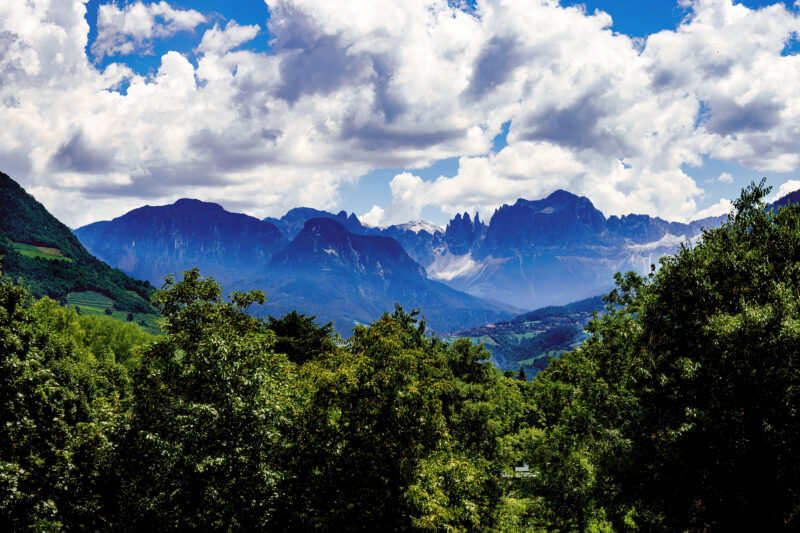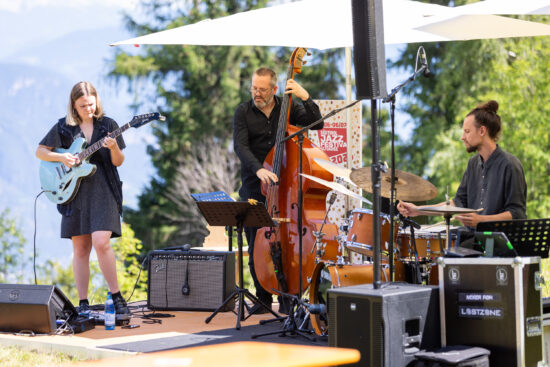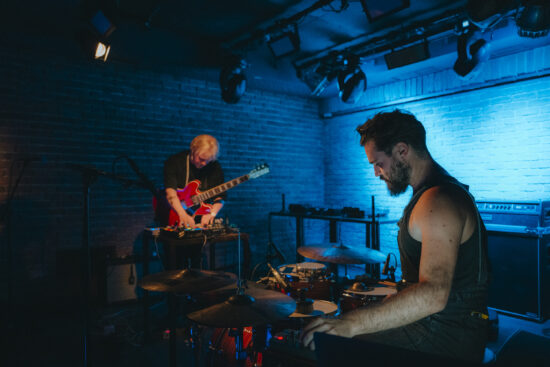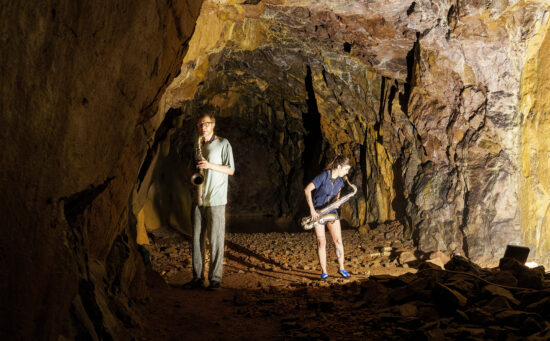Some jazz festivals are a bit like cults: People either haven’t heard of them or they’re passionately loyal to them, like their personal property. An example of the latter is the summer event based in Bolzano, Italy. Like everything in this part of Italy just below the Austrian border, the festival has two names, one German (Südtirol) and one Italian (Alto Adige). Most people call it Südtirol.
While it runs for ten days — this year presenting 60 concerts in 40 locations — the Südtirol Jazz Festival is neither large nor famous. Crowds tend to be small. Its home is Bolzano but it stages concerts in towns throughout the South Tyrol region. Two characteristics make the event special: the beauty of its physical setting and the hipness of its programming. You don’t go there to see big names. You go to hear emerging musicians, mostly young, mostly European, who give you insight into where jazz is going.
Wherever you find yourself, green mountains tower around you near and far, in every direction. In open spaces below the tree lines, there are terraced vineyards and occasionally castles. Above the tree lines are sheer cliff faces. On the far horizons, the serrated edges of silver Dolomite peaks cut into blue sky.

The festival finds creative ways to integrate music into its extraordinary local environment. Over the years it has put on concerts in 6,000-foot-high meadows, on rowboats on lakes, on bridges over deep canyons, on rock ledges, on trains and even in underground bunkers.
Brainteaser Begins
This year’s opening night took place in the main building of NOI Techpark, a science and technology facility that includes a university. The first concert was “Industrial Echoes,” with six players from the Dutch orchestra Brainteaser. They were Pau Sola (cello), Yanna Pelser (viola), Pablo Rodriguez (violin), Federico Calcagno (bass clarinet), Kika Sprangers (soprano and alto saxophones) and Aleksander Sever (vibraphone).
Each was positioned in a far corner of the huge hall, offering only murmurings and small, quick stabs of sound. Their fitful notes grew louder, and slowly the players all stepped toward the center of the space as their separate sonic fragments began to cohere into a melodic whole. When the six were finally together, their collective song rang out triumphantly and filled the hall. Then they all took out sheet music. The performance that followed was a strange, intricately notated chamber music.
Everyone then went outside on this warm Italian night, for a concert by the entire 13-piece Brainteaser Orchestra on the grounds of the Techpark. This ensemble has a sound all its own, one that blends explosive volatility with disciplined precision. The instrumentation is unusual: four strings, three reeds, trombone, vibraphone, guitar, keyboards, bass and drums.

Leader, conductor and keyboardist Tijn Wybenga explained and demonstrated the band’s methodology. He records the improvisations of band members, then samples and processes this material, selecting motifs and rhythmic patterns and assembling them into new songs. The compositions stack up motifs into dense forms. Wybenga provided an example titled “Kung Fu Paradox,” which had originated from a sample of a short improvised run by saxophonist Kika Sprangers. When the whole band attacked this motif and its many derivatives, the energy was ferocious.
Brainteaser is also full of hot soloists. Along with the six who appeared in “Industrial Echoes” are tenor saxophonist Nicolò Ricci, trombonist Nabou Claerhout and drummer Jamie Peet.
Brainteaser was at the center of things for the first three days, as ten different concerts featured at least one member. The most remarkable came on the second day, called “Floating Through Sound.” The audience was loaded into cable cars at a terminal in Bolzano, then rode up to Monte San Vigilio, over 5,000 feet above sea level. After exiting the cars, you could catch a single-person chairlift to continue up the mountain another thousand feet. As you climbed, you passed over nine members of Brainteaser, positioned at intervals on the forest floor below.
Intermittent birdsong notwithstanding, it is very quiet on a chairlift as you approach 6,000 feet. But as you floated upward you could hear an instrument faintly, growing louder. When you passed over the player below, the sound — a violin, or guitar, or trombone — rose up clearly from the trees. It faded away as you climbed, eventually replaced by the sound of the next instrument. This unique sequential encounter was repeated on the way down. Descending, the view took your breath away.


Brainteaser’s supercharged drummer, Jamie Peet, became subtle and sensitive for a trio set with Latvian guitarist Ella Zirina and Austrian bassist Robert Landfermann. Zirina’s lush guitar sonorities created a warm, intimate atmosphere — a considerable accomplishment given the setting for her outdoor concert. The three musicians played on the lawn of the Vigilius Mountain Resort, in front of a view that went forever, across vast Dolomite vistas.
Three members of Brainteaser turned up in a quartet that played on the “reading lawn” of the Biblioteca Civica (city library), in the idyllic village of Bressanone, 22 miles from Bolzano. Nicolò Ricci was joined by bassist/leader Alessandro Fongaro and bass clarinetist Federico Calcagno. The fourth, in her only appearance at the festival, was Sun-Mi Hong, now widely regarded as one of the most promising new drummers in Europe. The best piece was a haunting ballad, featuring an ethereal tenor saxophone/bass clarinet blend. It was a new Fongaro composition with a temporary title, “Nuovo Uno” (“new one”).

Raw Fish, on the other hand, played no haunting ballads. They were Brainteaser’s guitarist, Teis Semey, and Italian drummer Giovanni Iacovella, and they were raw indeed. Both musicians employed electronics to create loud, belligerent disturbances. Raw Fish was startling but never boring. They performed in Batzen Sudwerk, a dark, cramped cellar in Bolzano where, late at night, Südtirol tends to put the baddest of its bad boys and girls.
In the Dolomites, a Wisconsinite
If Brainteaser most influenced the early part of this festival, the second most important was Dan Kinzelman, often a featured artist at Südtirol. In 2025 he appeared four times, with wildly divergent projects.
Kinzelman was born and raised in Racine, Wisconsin and attended the University of Miami. After graduation in 2004, he emigrated to Italy for good. He has become a fixture on Italy’s improvised music scene (at 6’ 8” with blond hair and blue eyes, he stands out on an Italian stage).
Kinzelman’s first appearance was in a duo with fellow tenor saxophonist Camila Nebbia, from Argentina. It happened in the morning at Bunker H, a place that would not occur to most jazz festivals as a venue. It’s a series of tunnels deep within a mountain, constructed by the Nazis in 1943 as an air raid shelter. Those in attendance were led into a long, dark, cold tunnel. Footing was uncertain and jagged rock walls were close.

Eventually you came to a small chamber on the left where Nebbia, alone, played sudden runs in bursts that bounced off the close walls. When she fell silent the crowd moved tentatively on, and then heard Kinzelman up ahead, in short blasts and long calls. (In the reverberant acoustics of the tunnels, it was hard to know where certain sounds came from.) Soon Nebbia joined him, and together in a clearing they created abstract, contrapuntal tenor saxophone cacophony. Their cries felt like acts of the human spirit in defiance of this hostile environment.
Later that day, Kinzelman played duo with an A-list guitarist on the European scene, Reinier Baas of the Netherlands. After the morning’s Bunker H experience, it was a culture shock to hear Kinzelman (with lavish accompaniment from Baas) playing standards. But the weather sabotaged this concert.
The plan had been to hold the event on the grounds of a beautiful small hotel 20 miles from Bolzano. But rain forced the music indoors, into a room that could hold only about half the crowd that had shown up. From what your present correspondent could hear from his distant vantage point, Kinzelman and Baas sounded deeply committed to classics like “A Flower Is a Lovesome Thing” and “All or Nothing at All.”
The next day Kinzelman collaborated with two Belgians, bassist Lieven Van Pée and drummer Simon Segers, in a movie theater in Bolzano. They improvised a dynamic soundtrack to a 1918 silent film, Der Mandarin. The day after that, Kinzelman played with Italian trombonist Filippo Vignato, which had to be missed, although Vignato played a marvelous duo — short, quiet and intense — with Austrian guitarist Andreas Tausch in the intimate quarters of a small record store in Bolzano. Vignato is probably the most talented trombonist to come on the European scene since Gianluca Petrella.

Two last highlights deserve mention: A quartet called Purple Muscle Car, led by take-no-prisoners Austrian alto saxophonist Fabian Rucker, played a strong set in a fortress 45 minutes from Bolzano; and Antonia Hausmann’s quartet offered understated, refined music that, in ethos and sonority, was a world apart from Rucker’s. Hausmann is a meticulous trombonist who does not dominate her band. Her ensemble balances four distinct voices (the others are pianist Johannes Bigge, reed player Sebastian Wehle and drummer Philipp Scholz). They generate separate lines of thought that overlay into elegant and complete designs. JT
